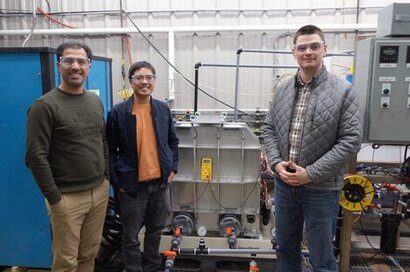
This designation confirms that the line is ready for low-rate initial production of Quino Energy’s proprietary quinone battery active material, a key component of commercial and grid-scale flow batteries.
The pilot line converts cheap and abundant dyestuff chemicals into high-performance, long-lifetime quinone battery active material through an electrochemical reaction, using a modified flow battery stack itself as the chemical reactor. The product from the reaction does not require downstream purification – meaning zero chemical waste – and can be directly cycled inside a commercial flow battery system. At full production rate, the line can produce up to 100 kWh of these organic battery material reactants per day at a cost comparable to or lower than vanadium, a critical material commonly sourced from Russia or China that has been used in most flow batteries to date. This production line represents the first example of US domestic manufacturing of flow battery active material and showcases how easily Quino Energy’s proprietary zero-waste production process can be scaled up to achieve lower costs.
The technology was developed with and is currently operated by Quino Energy partner Electrosynthesis Company at their facility near Buffalo, NY. Later in 2024, it will be relocated to a separate toll manufacturing site in Houston, TX where it will be further scaled to supply upcoming pilot demonstrations at the MWh scale.
Earlier this year, Quino Energy achieved technology readiness level (TRL) 6 for its quinone flow battery technology that is now running on its onsite microgrid. The organic active material was successfully demonstrated in commercial flow battery hardware originally designed for vanadium and has been shown in the lab to have a degradation rate of less than 1 percent per year, about three times lower than the lithium-ion phosphate (LFP) batteries typically used for grid storage applications. With real-world operation at a meaningful scale, and now the ability to mass-produce the organic reactant, together the TRL and MRL achievements showcase the viability and readiness of Quino Energy’s platform for commercialisation.
Quino Energy received $4.58M in funding through the US Department of Energy (DOE)’s Advanced Materials and Manufacturing Technologies Office (AMMTO) to support the development of this production line. This investment was part of the DOE’s ongoing efforts to strengthen the US domestic flow battery manufacturing ecosystem via scalable, cost‐effective and continuous processes for producing aqueous organic flow battery reactants.
“Now that we have reached TRL 6 and MRL 7, Quino is well-positioned to rapidly produce our innovative battery material and deliver systems to commercial customers at a meaningful scale” said Eugene Beh, co-founder and CEO of Quino Energy. “With this pilot production line, we will be able to produce flow battery reactants that are immediately cost-competitive with vanadium. Ultimately, Quino Energy’s technology will enable organic flow battery systems to reach half the cost of lithium-ion batteries. Our organic battery material will allow flow batteries to finally become a viable, mainstream choice for grid energy storage. We are especially grateful for the generous support from DOE AMMTO that made it possible to bridge the gap from making a few grams in the lab at Harvard to the full ton-scale pilot production line we have today.”
Renewables and electrical storage are essential to support deep decarbonisation efforts across global industries and economies. There is currently a massive long-term, unmet need for mid- to long-duration battery storage to even out times of excess renewable generation and support customer demand during peak periods. While short-duration grid storage up to four hours in duration has largely been served by lithium-ion batteries, flow batteries are emerging as an alternative well-suited to longer durations. For mid-duration energy storage applications between 4-40 hours, Quino Energy’s organic flow batteries can become significantly cheaper than incumbent lithium-ion batteries.
Quino Energy’s organic flow battery chemistry has the potential to become a leading technology in the expanding 8-24-hour, mid-duration energy storage market. It offers mid-duration energy storage at half the cost of lithium-ion, with a degradation rate three times lower than lithium iron phosphate batteries when cycled in the same manner. Additionally, Quino Energy’s solution does not require critical minerals or include dangerous synthetic chemicals like polyfluoroalkyl substances (PFAS) and presents zero fire risk.
Image: from left: Meisam Bahari, Ph.D., Co-Founder and CTO; Eugene Beh, Ph.D., Co-founder and CEO; Nathan Ball, EVP of Business Development
For additional information:

